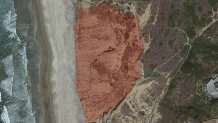Lifeguards confirmed to NBC 7 Friday afternoon that there was a bluff collapse at Black's Beach.
The beach is located north of La Jolla Shores, with the cliffs reaching heights of hundreds of feet. The collapse, which occurred a couple of hundred yards south of the Torrey Pines Glider Port, is estimated to be 250 feet wide and 25 feet high. Lifeguards are in pickup trucks near its base monitoring the situation.
There are no reports of injuries from the collapse, which was reported around 2 p.m. on Friday. Witnesses told NBC 7 that the incident took place relatively slowly, so anybody nearby was able to clear the scene before any danger was imminent.
Get top local stories in San Diego delivered to you every morning. Sign up for NBC San Diego's News Headlines newsletter.
Officials estimated the volume of the collapse at 150,000 cubic yards.
Local
"For about 10 minutes chunks of rock falling along the ledge, then just massive piles started falling and collapsing onto the beach so slowly," a surfer told NBC 7, adding, "I think it happened so slowly, you'd see so many chunks starting to fall that everybody was backing up already."
Lifeguards cordoned off the debris field after the collapse, and the La Jolla Walking Trail was closed where it meets the Citizen Trail as well.
“This is the biggest landslide we’ve seen around here in many years but it's actually a piece of an old one that didn't finish sliding," said Dr. Pat Abbott, Professor of Geology Emeritus at San Diego State University.
Dr. Abbott said that almost 41 years ago to the date, another major collapse happened in that area. Many of the cliffs near San Diego's beach communities have seen some sort of failure at one point, Dr. Abbott added.
"Five times since 1995, we've had sea cliff failures in San Diego County that have killed one to five people each time," Dr. Abbott added.
Collapses aren't too common, but they do happen, especially when conditions line up, according to Dr. Abbott.
"High sea cliffs, waves eating at the base, gravity pulling on it constantly, less sand on the beach in the winter, higher tides, all those things increase the probability of cliff failure," said Dr. Abbott.
Rain is also a contributing factor, Dr. Abbott said.
"You saturate those rocks with water, that makes them weaker and makes them heavier, which allows gravity to pull with more effective force during these times," Dr. Abbott said.
He said that collapses like this will keep happening and while there might be ways to try and prevent them, it might not be worth the effort.
"We can take those cliffs and we can grade them back and flatten them like this. We can put up big concrete walls and we can do all those things that would fundamentally spoil the environment. So do we live with mother nature and learn to adapt or are we going to battle her and try to combat and turn everything to concrete and heavy rocks?” asked Dr. Abbott.




